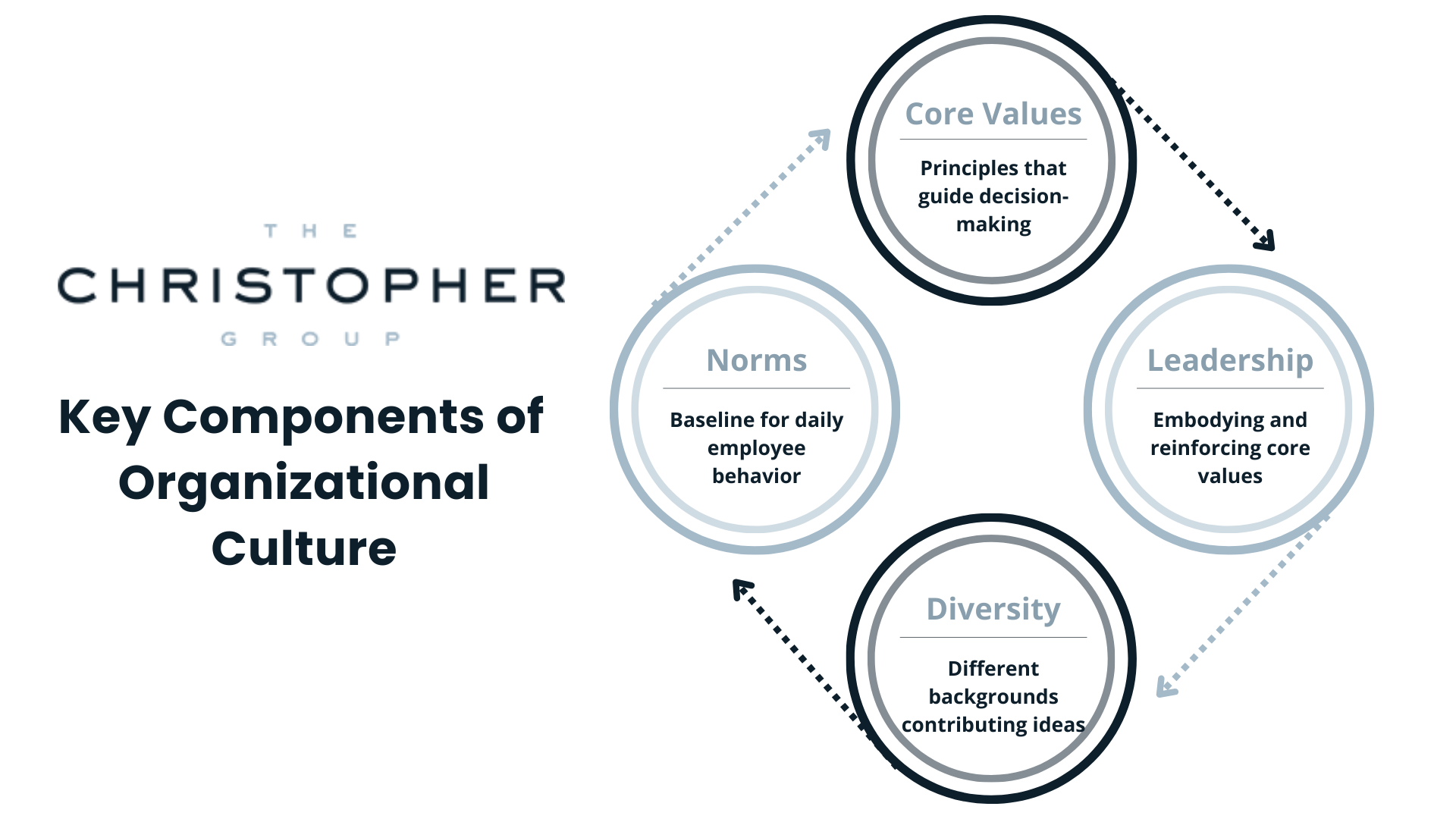How Organizational Culture Influences Employee Behavior
Organizational culture profoundly impacts employee motivation, engagement, and interaction within the workplace. A well-defined and positive culture fosters a sense of belonging, encourages employees to align with the company’s values, and drives them to perform at their best. By influencing how people work, communicate, and interact with one another, culture plays a crucial role in workplace dynamics and success.
Key Components of Organizational Culture
Organizational culture refers to the shared values, beliefs, and norms that shape how employees behave, make decisions, and interact in the workplace. It acts as an invisible guide that influences behavior, helping employees understand the company’s expectations and goals. A strong corporate culture is integral to business success, as it aligns employees with the company’s mission and motivates them to contribute to the organization’s objectives.
Core Values, Leadership, Diversity, and Norms
Several components make up a company’s culture, including core values, leadership, diversity, and norms. These elements create a framework for how employees behave and engage with one another.

- Core Values: Provide a set of principles that guide decision-making and interactions.
- Leadership: Plays a critical role in embodying and reinforcing core values.
- Diversity: Ensures that employees from different backgrounds contribute unique perspectives and ideas.
- Norms: Establish a baseline for daily employee behavior, such as how meetings are conducted or how feedback is delivered.
Open communication and a clear mission statement also foster a positive culture by ensuring everyone understands the organization’s goals and how their work contributes to achieving them. These factors create an environment that supports work-life balance, job satisfaction, and overall employee well-being.
The Role of Leadership in Shaping Organizational Culture
Leadership Styles and Employee Engagement
Leaders have a powerful influence on shaping organizational culture. Different leadership styles—such as transformational, transactional, or laissez-faire—can significantly affect employee engagement and behavior.
Transformational leadership, for example, inspires employees by promoting a shared vision and encouraging innovation, while transactional leadership focuses on maintaining structure through rewards and consequences.
Effective leadership fosters a culture that promotes ethical behavior and continuous improvement. Leaders are responsible for setting the tone, creating an environment that aligns with the organization’s values, and encouraging employees to engage in behaviors that support the company’s mission.
Promoting Ethical Behavior and Continuous Improvement
When leaders prioritize ethical behavior, they establish a standard that influences all aspects of organizational behavior. Employees who observe their leaders acting ethically are more likely to do the same, creating a culture of integrity and trust.
Additionally, leaders who promote continuous improvement encourage employees to seek personal and professional growth, driving a culture that values learning and adaptability.
The Impact of Culture on Employee Engagement and Performance
Aligning Values for Greater Engagement
When an organization’s values align with employees’ personal values, it leads to higher levels of engagement. Employees who feel connected to their company’s culture are more likely to be motivated, committed, and satisfied with their work. This alignment fosters a sense of purpose, making employees more willing to go the extra mile and contribute to the company’s long-term goals.
A strong organizational culture also enhances employee performance by promoting meaningful work. When employees feel that their work matters and aligns with the company’s mission, they become more productive and loyal. This can lead to a competitive advantage for the organization, as engaged team members are more likely to innovate, collaborate, and deliver higher-quality results.
Employee Retention
A positive workplace culture also contributes to employee retention. When employees feel supported, valued, and connected to the company’s mission, they are more likely to stay with the organization. High levels of job satisfaction, work-life balance, and shared values help foster long-term commitment, reducing turnover and strengthening organizational performance.
Types of Organizational Cultures and Their Effect on Behavior
Different organizations cultivate different cultures based on their industry, goals, and needs. Some common types of organizational cultures include hierarchical, market-driven, and adhocracy cultures:
- Hierarchical Culture: Emphasize structure, stability, and clear chains of command. Employees in these environments may be more focused on following established procedures and maintaining consistency in their work.
- Market-Driven Culture: Prioritize competitiveness, results, and performance. In these environments, employees may be highly motivated to meet targets and excel in their roles.
- Adhocracy Culture: Encourage innovation, flexibility, and risk-taking. Employees in these organizations are often more creative, entrepreneurial, and willing to experiment with new ideas.
Each type of culture influences how employees approach their work, interact with colleagues, and engage with organizational goals.
Assessing and Evolving Company Culture
Company leaders must regularly assess their current culture to ensure it supports a positive work environment. This can be done through employee feedback, surveys, and performance reviews.
By understanding the cultural dynamics within the organization, leaders can make necessary adjustments to foster a more inclusive, engaging, and productive workplace. Continuous assessment and improvement are key to maintaining a culture that drives business success and enhances employee well-being.
Creating a Culture That Drives Business Success
To build a culture that drives business success, companies must invest in leadership skills and encourage open communication. Leaders should be equipped to guide their teams through challenges, promote ethical behavior, and foster a sense of belonging among employees. Effective communication ensures that everyone understands the organization’s goals and how their work contributes to achieving those goals.
Another critical element of a successful culture is employee well-being. Companies that prioritize work-life balance, mental health, and job satisfaction are more likely to retain top talent and maintain a productive workforce. A culture that supports employees’ personal and professional needs leads to long-term success by creating a motivated and loyal team.
The Role of The Christopher Group in Cultural Alignment
At TCG, we help organizations identify HR leaders who align with their cultural needs and can contribute to creating a thriving, high-performance environment. Whether companies need a fractional CHRO, an interim HR leader, or a full-time HR executive, we provide the expertise to help build a culture that supports business success. Our approach ensures that organizations have the right HR leadership in place to drive cultural change, improve employee engagement, and promote organizational outcomes.
Enhancing Organizational Culture with Strategic HR Leadership
Human resources leadership plays a pivotal role in shaping and maintaining an organization’s culture. HR professionals are responsible for developing policies, implementing training programs, and supporting initiatives that align with the company’s cultural values. Having the right HR leadership in place ensures that the company’s culture is reinforced at every level of the organization.
At TCG, we specialize in placing top HR professionals who understand how to build and support a positive organizational culture. Whether an organization is looking to enhance its existing culture or undergo an organizational change, our HR experts have the skills and experience to guide the process.
Partner with TCG
If your organization is striving to enhance its culture, having the right HR leadership is essential. At The Christopher Group, we offer a range of solutions to support your HR needs, from executive search and HR advisory services to interim leadership.
Contact us today to schedule a consultation and learn how we can help you build a strong, positive organizational culture.
Resources:
- Forbes. https://www.forbes.com/sites/tracylawrence/article/organizational-culture/
- Harvard Business Review. https://hbr.org/2013/05/what-is-organizational-culture



